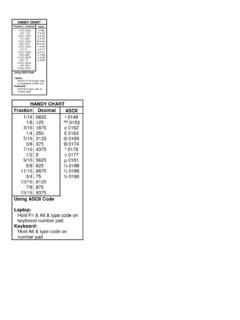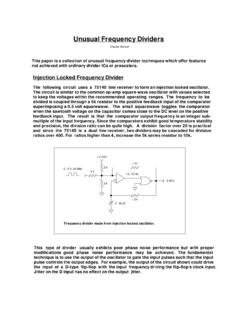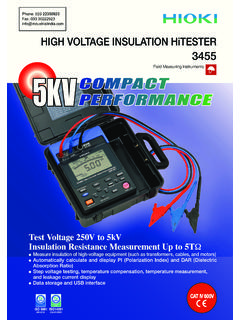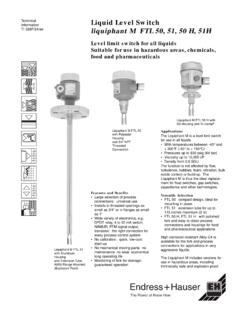Transcription of A Low Noise Amplifier for Phase Noise Measurements
1 A Low Noise Amplifier for Phase Noise MeasurementsCharles WenzelThe Phase Noise of low Noise oscillators and signal sources is usually determined by measuring theaudio Noise voltage at the output of the Phase comparator in a Phase -locked loop. The phasecomparator is typically a low Noise doubly-balanced mixer with a Phase slope from a few tenths of avolt per radian to a few volts per radian. The low conversion gain of this type of Phase detector yields asignal in the low nanovolt per root-hertz range for very low Noise sources which is a level below thenoise floor of most spectrum analyzers. Suitable low Noise preamplifiers are readily constructed fromdiscrete components or from modern low- Noise for the Noise voltage, the Amplifier requirements are not particularly demanding.
2 Since theoutput impedance of the Phase detector is low, the input impedance of most Amplifier circuits isadequate. A frequency response from a few hertz to 100kHz is usually adequate and the output load isusually a high impedance spectrum analyzer and oscilloscope. The Phase detector output impedance isquite low so the Noise current of ordinary bipolar transistors is sufficiently low. For example, anordinary 2N4403 transistor exhibits a Noise voltage below 1 nanovolt at 10 Hz when the source is atypical Schottky diode mixer. Several op-amps are available with Noise voltages below 3 nanovolts anda few are available with Noise voltage below 1 nanovolt.
3 Simple amplifiers built from any of theseparts will perform well in most applications. Bulk-metal, wirewound, and metal film resistors exhibitlittle excess Noise and should be used instead of carbon film or carbon composition types. Mostpotentiometers should be avoided since film and cermet types are quite the Amplifier requirements are minimal, there are several features which may be added toenhance the measurement system. The Phase slope of the Phase detector is often measured byobserving the beat-note of the free-running oscillators. Most simple Amplifier circuits will distort thisbeat-note when they overload so they must be disconnected when checking the Phase slope.
4 In someinstances, the question of whether reconnecting the Amplifier changes the Phase slope will arise. Forexample, the normal low impedance termination used at the output of the Phase detector may be leftout to achieve a higher Phase slope but such an unterminated Phase detector can be sensitive tochanges in the output load. An adjustable gain Amplifier which remains connected to the input avoidsthe problem. The gain of the Amplifier is set to unity for measuring the Phase slope then switched tohigh gain for making the desirable feature is an adjustable low frequency rolloff. The Amplifier should be capable of DCresponse and two or three AC high-pass selections are helpful.
5 The DC response allows very close-inphase Noise Measurements and the AC responses allow high gain Measurements of the Noise floor evenin the presence high level close-in Noise . A fairly high frequency high pass response is also usefulwhen observing jumpy oscillators on an oscilloscope. A high-pass rolloff at Hz is alsorecommended since many Phase Noise Measurements only extend down to 10 Hz and the high-passwill reduce the settling time . The DC gain should be below 40 dB since it is used mainly for close-innoise and excessive gain might result in clipping when measuring noisy oscillators. (Alternately, thephase slope of the detector may be reduced by attenuating one of the Phase detector inputs but a simplegain switch on the Amplifier is more convenient.)
6 The Amplifier should have some RF filtering at the input so that the carrier and sum frequencies fromthe Phase detector do not reach the gain stages. A simple L-C filter with a resonant frequency wellabove the Amplifier s frequency response and well below the measured oscillator s frequency is usuallyadequate. More complex filtering will be necessary if the Amplifier s response must approach thefrequency of the oscillators. For example, measuring the Phase Noise of 1 MHz oscillators out to 100kHz might require a special filter to prevent the Amplifier from overloading. Specific frequency trapsmay be placed across the Amplifier to reduce particular convenience is a unity-gain buffer Amplifier between the Phase detector and the PLL buffer prevents the PLL circuit from disturbing the Phase slope measurement due to PLL amplifieroverload.
7 A high-impedance buffer also prevents the PLL circuit elements from limiting the utility ofthe low Noise Amplifier . For example, the Amplifier may be used to measure the audio Noise in aprototype circuit but a low resistance PLL input resistor might excessively load the point to 1 shows a complete ultra-low Noise Amplifier with the features described above. The input circuitincludes two 2SK369 JFETs connected in parallel to achieve a remarkably low Noise voltage. Thesesurprisingly low Noise transistors exhibit a Noise floor near nanovolts with the Noise rising to nanovolts at 10 Hz. The JFETs and the LM833 first stage give a DC-coupled gain of 30 exhibiting enough Noise to cause this stage to clip are quite noisy and may be measuredwith the gain set to 0 dB!
8 A second 30 dB Amplifier is included for the AC-coupled settings giving atotal AC gain of 60 dB. Three AC frequency responses are selected by a multi-pole switch. A bufferdrives two BNC connectors, one for a spectrum analyzer and one for an oscilloscope. The PLL is fairlyordinary except that a buffer is provided at the input and a manual slew switch is added to speedphase locking. R1, R2 and C1 may be connected with binding posts to allow for easy modifications. A10k potentiometer may be added across the PLL output to manually adjust the tuning sensitivity forvarious one adjustment must be made to the Amplifier circuit. The 2N5639 s source resistor must beselected to bring the Amplifier s output near zero volts with the input shorted.
9 This FET is a simplecurrent source which sinks just enough current to bring the drains of the 2SK369s down to the voltageon the positive input of the LM833 (set by a resistor divider). Other FETs may be substituted for the2N5639 as long as the Idss is above about 25 mA. - + - + - + - + + -3083108333108332, 2SK3692N5639100 uF10 uFAC1 ( Hz)AC2 (25 Hz)AC3 (650 Hz) dB0 dB+15-15 Manual PLL slew(use a momentary switch)150 pFR1R2C1> 1 Megohm100 pF30/60 dB 0 dBSelect to obtainzero volts out withinput grounded.(Near 100 ohms)Current will be near19 Ohm680 Ohm68 uF+750 Ohm330 Ohm820 pF420 Ohm1000 pF1000 pF47 uH+15 Bypass the supplies!+-220 uF220 uF+15-15A few uF capacitors acrossthe op-amps are (Approx.)
10 1dB freqs. Varycapacitors as desired.)Gain = 30dBGain = 30 dB60 dB response approx. dB at 50 kHz dB at 80 kHz dB at 100 kHz30 dB response approx. dB at 80 kHz dB at 100 nV/ Hz nV at 10 HzFigure 1: A complete ultra-low Noise Amplifier and PLL for Phase - Noise , R2, and C1 are selected to obtain the desired PLL response. Select a slow loop response below the lowest frequency to be measured. For example, use a one hertzbandwidth for Measurements down to 10 Hz. The manual slew switch may be used to speed Phase lock. Ordinary PLL mathematics apply to this setup, the 310 is simplya unity gain buffer and does not impact the Meg.+15









